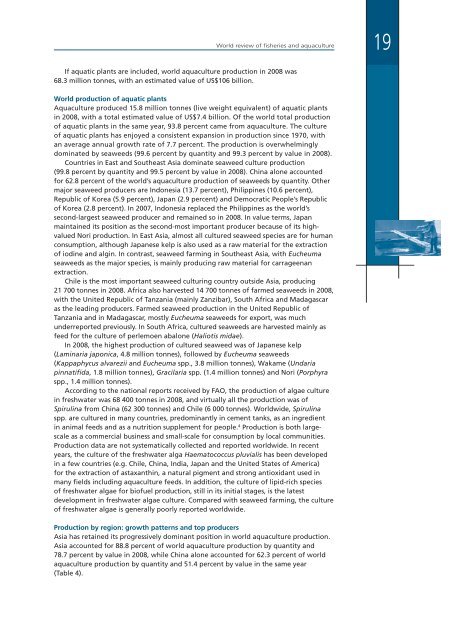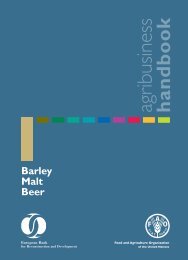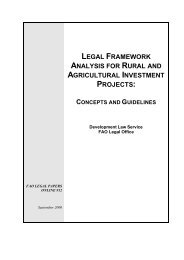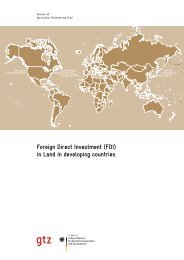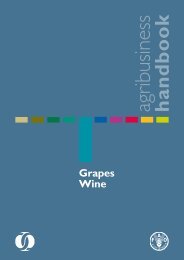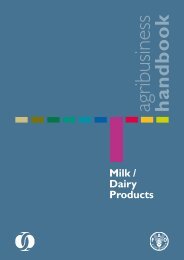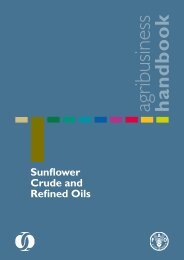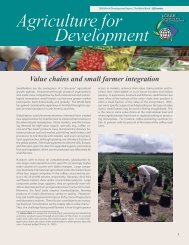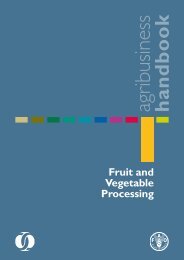The State of World Fisheries and Aquaculture 2010 - FAO
The State of World Fisheries and Aquaculture 2010 - FAO
The State of World Fisheries and Aquaculture 2010 - FAO
You also want an ePaper? Increase the reach of your titles
YUMPU automatically turns print PDFs into web optimized ePapers that Google loves.
<strong>World</strong> review <strong>of</strong> fisheries <strong>and</strong> aquaculture<br />
19<br />
If aquatic plants are included, world aquaculture production in 2008 was<br />
68.3 million tonnes, with an estimated value <strong>of</strong> US$106 billion.<br />
<strong>World</strong> production <strong>of</strong> aquatic plants<br />
<strong>Aquaculture</strong> produced 15.8 million tonnes (live weight equivalent) <strong>of</strong> aquatic plants<br />
in 2008, with a total estimated value <strong>of</strong> US$7.4 billion. Of the world total production<br />
<strong>of</strong> aquatic plants in the same year, 93.8 percent came from aquaculture. <strong>The</strong> culture<br />
<strong>of</strong> aquatic plants has enjoyed a consistent expansion in production since 1970, with<br />
an average annual growth rate <strong>of</strong> 7.7 percent. <strong>The</strong> production is overwhelmingly<br />
dominated by seaweeds (99.6 percent by quantity <strong>and</strong> 99.3 percent by value in 2008).<br />
Countries in East <strong>and</strong> Southeast Asia dominate seaweed culture production<br />
(99.8 percent by quantity <strong>and</strong> 99.5 percent by value in 2008). China alone accounted<br />
for 62.8 percent <strong>of</strong> the world’s aquaculture production <strong>of</strong> seaweeds by quantity. Other<br />
major seaweed producers are Indonesia (13.7 percent), Philippines (10.6 percent),<br />
Republic <strong>of</strong> Korea (5.9 percent), Japan (2.9 percent) <strong>and</strong> Democratic People’s Republic<br />
<strong>of</strong> Korea (2.8 percent). In 2007, Indonesia replaced the Philippines as the world’s<br />
second-largest seaweed producer <strong>and</strong> remained so in 2008. In value terms, Japan<br />
maintained its position as the second-most important producer because <strong>of</strong> its highvalued<br />
Nori production. In East Asia, almost all cultured seaweed species are for human<br />
consumption, although Japanese kelp is also used as a raw material for the extraction<br />
<strong>of</strong> iodine <strong>and</strong> algin. In contrast, seaweed farming in Southeast Asia, with Eucheuma<br />
seaweeds as the major species, is mainly producing raw material for carrageenan<br />
extraction.<br />
Chile is the most important seaweed culturing country outside Asia, producing<br />
21 700 tonnes in 2008. Africa also harvested 14 700 tonnes <strong>of</strong> farmed seaweeds in 2008,<br />
with the United Republic <strong>of</strong> Tanzania (mainly Zanzibar), South Africa <strong>and</strong> Madagascar<br />
as the leading producers. Farmed seaweed production in the United Republic <strong>of</strong><br />
Tanzania <strong>and</strong> in Madagascar, mostly Eucheuma seaweeds for export, was much<br />
underreported previously. In South Africa, cultured seaweeds are harvested mainly as<br />
feed for the culture <strong>of</strong> perlemoen abalone (Haliotis midae).<br />
In 2008, the highest production <strong>of</strong> cultured seaweed was <strong>of</strong> Japanese kelp<br />
(Laminaria japonica, 4.8 million tonnes), followed by Eucheuma seaweeds<br />
(Kappaphycus alvarezii <strong>and</strong> Eucheuma spp., 3.8 million tonnes), Wakame (Undaria<br />
pinnatifida, 1.8 million tonnes), Gracilaria spp. (1.4 million tonnes) <strong>and</strong> Nori (Porphyra<br />
spp., 1.4 million tonnes).<br />
According to the national reports received by <strong>FAO</strong>, the production <strong>of</strong> algae culture<br />
in freshwater was 68 400 tonnes in 2008, <strong>and</strong> virtually all the production was <strong>of</strong><br />
Spirulina from China (62 300 tonnes) <strong>and</strong> Chile (6 000 tonnes). <strong>World</strong>wide, Spirulina<br />
spp. are cultured in many countries, predominantly in cement tanks, as an ingredient<br />
in animal feeds <strong>and</strong> as a nutrition supplement for people. 4 Production is both largescale<br />
as a commercial business <strong>and</strong> small-scale for consumption by local communities.<br />
Production data are not systematically collected <strong>and</strong> reported worldwide. In recent<br />
years, the culture <strong>of</strong> the freshwater alga Haematococcus pluvialis has been developed<br />
in a few countries (e.g. Chile, China, India, Japan <strong>and</strong> the United <strong>State</strong>s <strong>of</strong> America)<br />
for the extraction <strong>of</strong> astaxanthin, a natural pigment <strong>and</strong> strong antioxidant used in<br />
many fields including aquaculture feeds. In addition, the culture <strong>of</strong> lipid-rich species<br />
<strong>of</strong> freshwater algae for bi<strong>of</strong>uel production, still in its initial stages, is the latest<br />
development in freshwater algae culture. Compared with seaweed farming, the culture<br />
<strong>of</strong> freshwater algae is generally poorly reported worldwide.<br />
Production by region: growth patterns <strong>and</strong> top producers<br />
Asia has retained its progressively dominant position in world aquaculture production.<br />
Asia accounted for 88.8 percent <strong>of</strong> world aquaculture production by quantity <strong>and</strong><br />
78.7 percent by value in 2008, while China alone accounted for 62.3 percent <strong>of</strong> world<br />
aquaculture production by quantity <strong>and</strong> 51.4 percent by value in the same year<br />
(Table 4).


